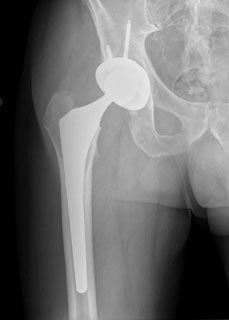Modular components in total hip arthroplasty allow for greater flexibility for the surgeon; however, head-neck corrosion or trunnionosis can lead to adverse local tissue reactions (ALTR). A cobalt chrome head on a titanium taper can lead to trunnionosis over time. Crevice corrosion leads to metal ion release which can lead to a lymphocytic response and an ALTR. Infection must be ruled out with aspiration prior to revision. Metal debris may lead to a falsely elevated synovial WBC on automated cell count and therefore manual cell count should be performed when head-neck corrosion is suspected. Serum cobalt levels are often elevated 4-5 times as much as chromium levels in head-neck corrosion. Trunnionosis is thought to occur secondary to larger femoral heads, cobalt chrome heads on titanium tapers, and thinner and shorter trunnions. Treatment should consist of revision arthroplasty with debridement, liner exchange, and cleaning of the taper followed by a ceramic head with a titanium sleeve.
Review more high-yield concepts about THA Trunnionosis
on the most recent episode of The Orthobullets Podcast. Listen wherever you get your podcasts! https://anchor.fm/…/…/ReconTHA-Trunnionosis-edisgl/a-a23jr2i
